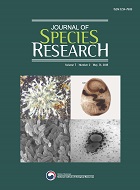Report on 30 unrecorded bacterial species of the phylum Firmicutes isolated from Korea in 2016
차창준 (중앙대학교)
배진우 (경희대학교)
임완택 (한경대학교)
장광엽 (전북대학교)
조기성 (한국외국어대학교)
김원용 (중앙대학교)
이순동 (제주대학교)
이하나 (고려대학교)
이도훈 (중앙대학교)
- 다운로드 수
- 조회수
Abstract
During the course of investigation of indigenous prokaryotic species in Korea, a total of 30 bacterial strains belonging to the phylum Firmicutes were isolated from diverse environmental sites such as soil, avian feces, wastewater treatment plants, fermented vegetables, seawater, algae, sea cucumber, octopus and tidal flat sediment. Phylogenetic analysis based on 16S rRNA gene sequences revealed that each strain showed high sequence similarity (≥98.7%) to the closest type strain and formed a robust phylogenetic clade with the most closely related species in the phylum Firmicutes. To date, there is no official record of these 30 species in Korea. Therefore, we report 26 species of 12 genera in the order Bacillales and 4 species of 4 genera in the order Lactobacillales which have not been reported in Korea. Morphological and biochemical characteristics, isolation sources and NIBR deposit numbers are described in the species descriptions.
- keywords
- 16S rRNA, Firmicutes, indigenous Korean prokaryotic species, unreported species
참고문헌
Carr, F.J., D. Chill and N. Maida. 2002. The lactic acid bacteria: a literature survey. Critical Reviews in Microbiology 28:281-370.
Edgar, R.C. 2004. MUSCLE: multiple sequence alignment with high accuracy and high throughput. Nucleic Acids Res 32:1792-1797.
Felsenstein, J. 1981. Evolutionary trees from DNA sequences: a maximum-likelihood approach. Journal of Molecular Evolution 17:368-376.
Felsenstein, J. 1985. Confidence limits on phylogenies: an approach using the bootstrap. Evolution 39:783-791.
Haakensen, M., C.M. Dobson, H. Deneer and B. Ziola. 2008. Real-time PCR detection of bacteria belonging to the Firmicutes phylum. International Journal of Food Microbiology 125:236-241.
Kim, O.S., Y.J. Cho, K. Lee, S.H. Yoon, M. Kim, H. Na, S.C. Park, Y.S. Jeon, J.H. Lee, H. Yi, S. Won and J. Chun. 2012. Introducing EzTaxon-e: a prokaryotic 16S rRNA gene sequence database with phylotypes that represent uncultured species. International Journal of Systematic and Evolutionary Microbiology 62:716-721.
Kumar, S., G. Stecher and K. Tamura. 2016. MEGA7: Molecular Evolutionary Genetics Analysis Version 7.0 for Bigger Datasets. Molecular Biology and Evolution 33:1870-1874.
Lee, D.H. and C.J. Cha. 2016. Flavihumibacter sediminis sp. nov., isolated from tidal flat sediment. International Journal of Systematic and Evolutionary Microbiology 66:1-5.
Ludwig, W., K.H. Schleifer and W.B. Whitman. 2009. Revised road map to the phylum Firmicutes. Bergey's Manual of Systematic Bacteriology. Springer, New York.
Posada, D. 2008. jModelTest: phylogenetic model averaging. Molecular Biology and Evolution 25:1253-1256.
Saitou, N. and M. Nei. 1987. The neighbor-joining method: a new method for reconstructing phylogenetic trees. Molecular Biology and Evolution 4:406-425.
Sakamoto, K. and W.N. Konings. 2003. Beer spoilage bacteria and hop resistance. International Journal of Food Microbiology 89:105-124.
Schliep, K.P. 2011. phangorn: phylogenetic analysis in R. Bioinformatics 27:592-593.
Teusink, B. and E.J. Smid. 2006. Modelling strategy for the industrial exploitation of lactic acid bacteria. Nature Reviews Microbiology 4:46-56.
- 다운로드 수
- 조회수
- 0KCI 피인용수
- 0WOS 피인용수


